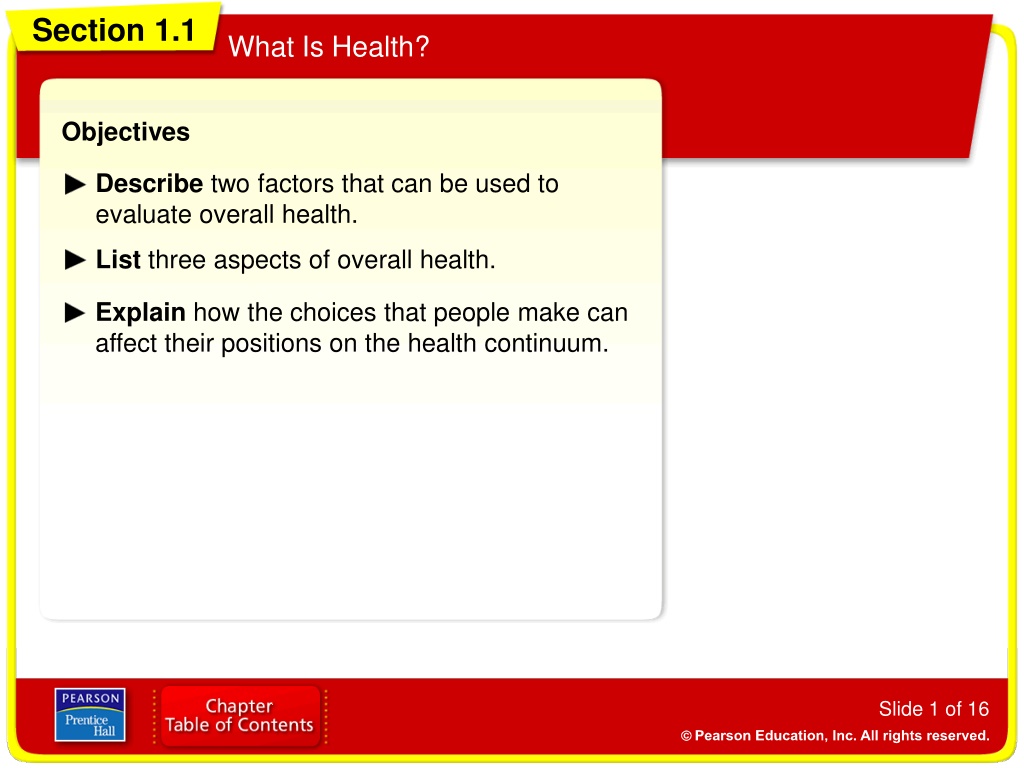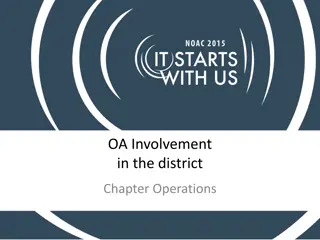
Understanding Overall Health and Well-being
Explore the concept of health, factors influencing it, and the aspects contributing to a high quality of life. Learn about physical, mental, and social health, and how they intersect to enhance overall well-being. Discover the impact of personal choices on the health continuum.
Download Presentation

Please find below an Image/Link to download the presentation.
The content on the website is provided AS IS for your information and personal use only. It may not be sold, licensed, or shared on other websites without obtaining consent from the author. Download presentation by click this link. If you encounter any issues during the download, it is possible that the publisher has removed the file from their server.
E N D
Presentation Transcript
Section 1.1 Section 1.1 What Is Health? What Is Health? Objectives Describe two factors that can be used to evaluate overall health. List three aspects of overall health. Explain how the choices that people make can affect their positions on the health continuum. Slide 1 of 16
Section 1.1 What Is Health? Health Stats The graph shows data on the average life span of people in the United States. How did the average life span change from 1900 to 2000? What are some possible reasons for this trend? Slide 2 of 16
Section 1.1 What Is Health? Health Today Health refers to the overall well-being of your body, your mind, and your relationships with other people. Life Expectancy The number of years a person can expect to live is called life expectancy. Quality of Life Quality of life is the degree of overall satisfaction that a person gets from life. High quality of life can be a person s goal. A goal is a result that a person aims for and works hard to reach. Slide 3 of 16
Section 1.1 What Is Health? Aspects of Health To achieve a high quality of life, a person must work hard to improve all aspects of health. The aspects of health that are important to overall well-being are physical health, mental and emotional health, and social health. Slide 4 of 16
Section 1.1 What Is Health? Physical Health Physical health refers to how well your body functions. A healthy diet, regular exercise, adequate sleep, and proper medical and dental care are all important for physical health. Slide 5 of 16
Section 1.1 What Is Health? Mental and Emotional Health The state of being comfortable with yourself, with others, and with your surroundings is called mental health. Emotional health refers to how you react to events in your life. A healthy diet, regular exercise, adequate sleep, and proper medical and dental care are all important for physical health. Slide 6 of 16
Section 1.1 What Is Health? Social Health Social health refers to how well you get along with others. Building healthy relationships with family and friends is important for social health. Slide 7 of 16
Section 1.1 What Is Health? A Continuum of Health Defining a Continuum A continuum (kun TIN yoo um) is a gradual progression through many stages between one extreme and another. A Health Continuum One end of the continuum represents poor health (illness). The other end represents perfect, or ideal, health (wellness). Wellness is a state of high-level health. Movement Along the Continuum Many of the choices you make on a daily basis affect your position on the health continuum. Slide 8 of 16
Section 1.1 What Is Health? A Continuum of Health Slide 9 of 16
Section 1.1 What Is Health? Vocabulary The overall well-being of your body, mind, and your relationships with other people. health life expectancy The number of years a person can expect to live. The degree of total satisfaction that a person gets from life. A result that a person aims for and works hard to reach. The aspect of health that refers to how well your body functions. When you are physically healthy you have enough energy to carry out everyday tasks. quality of life goal physical health Slide 10 of 16
Section 1.1 What Is Health? Vocabulary The state of being comfortable with yourself, with others, and with your surroundings. mental health The aspect of health that refers to how you react to events in your life. You are emotionally healthy when the feelings you experience are appropriate responses to events. emotional health social health The aspect of health that refers to how well you get along with others. continuum A gradual progression through many stages between one extreme and another. A state of high-level health. wellness Slide 11 of 16
Section 1.1 What Is Health? QuickTake Quiz qt_logo-New Click to start quiz. Video-InstallQTQbtn Slide 12 of 16
Section 1.1 Section 1.2 What Is Health? Identifying Health Risks Objectives Identifyfactors that can influence a person s health. Describe three strategies you can use to evaluate risk factors. Slide 13 of 21
Section 1.1 What Is Health? Myth Using a cell phone puts a person at risk of developing cancer. Fact Cell phone use does not increase the risk of developing cancer. However, cell phone use while driving does greatly increase the risk of car crash. Where do you think people get their information about health risks? How reliable are those sources of information? Slide 14 of 21
Section 1.1 What Is Health? Influences on Health Factors that can influence health include heredity environment media technology healthcare behavior Slide 15 of 21
Section 1.1 What Is Health? Heredity To some extent, your level of health is already determined when you were born. Your heredity, all the traits that are passed biologically from parent to child. Even if you inherit a risk factor, you can lower your overall risk by avoiding other risk factors. Another part of your heredity is your gender whether you are male or female. Slide 16 of 21
Section 1.1 What Is Health? Physical Environment The environment is all the physical and social conditions that surround a person and can influence that person s health. Your physical environment includes both your outdoor and indoor surroundings. Being aware of potential risks in your physical environment can help you protect your health. Slide 17 of 21
Section 1.1 What Is Health? Social Environment Your social environment includes the people you spend time with your family, friends, classmates, and other people in your community. Your social environment is healthier when you choose friends who show concern for their own health and yours. Slide 18 of 21
Section 1.1 What Is Health? Culture Culture is the beliefs and patterns of behavior that are shared by a group of people and passed from generation to generation. In some cultures, public displays of emotion are typical. In other cultures people tend to keep their emotions private. Slide 19 of 21
Section 1.1 What Is Health? Media Media are forms of communication that provide news and entertainment. Media can have a positive or negative influence on your health. You might receive useful information from a public service announcement or from a news report on a health topic. Some characters on television shows may be poor role models who indulge in risky behavior. Slide 20 of 21
Section 1.1 What Is Health? Technology Advances in technology help doctors to detect health problems sooner and improve the quality of life for patients. Some Web sites provide accurate information about health. Others are filled with misleading or self-serving information. Be sure to consider the source of the information on a Web site and the purpose of the site. Slide 21 of 21
Section 1.1 What Is Health? Healthcare Healthcare includes the medical services provided by doctors, nurses, dentists, and therapists. Healthcare also includes the places these people work, such as clinics and hospitals. Slide 22 of 21
Section 1.1 What Is Health? Behavior Sometimes behaviors become habits. A habit is a behavior that is repeated so often that it becomes almost automatic. Unhealthy habits can be broken. You can set a goal to change your behavior. Your goal should include a plan for changing your habit. Slide 23 of 21
Section 1.1 What Is Health? Evaluating Health Risks A risk factor is any action or condition that increases the likelihood of injury, disease, or other negative outcome. Consider both short- and long-term consequences. Decide whether you can control the risk factor. Analyze the possible benefits and risks of a decision. Slide 24 of 21
Section 1.1 What Is Health? Short- and Long-Term Consequences Some behaviors can have an immediate effect on your health. With some risky behaviors, the consequences are not immediate. It can be very difficult to change habits that have existed for years. Even if you do change your risky behaviors later in life, you may not be able to repair the damage you may have done to your body. Slide 25 of 21
Section 1.1 What Is Health? Risk Factors You Cannot Control You can t control the color of your skin or other risk factors that are part of your heredity. Nor can you control all the risk factors in your environment. Slide 26 of 21
Section 1.1 What Is Health? Risk Factors You Can Control You can control these risk factors that are related to your behavior. your level of physical activity your intake of fat, sugar, or salt your use of tobacco, alcohol, and other drugs your use to protective gear, such as seat belts your choice of friends Slide 27 of 21
Section 1.1 What Is Health? Analyzing Benefits and Risks Without taking risks and trying new things, it would be impossible to grow as a person. You need to weigh the risks of an action against the possible benefits. Slide 28 of 21
Section 1.1 What Is Health? A risk-benefit chart can help you decide whether to accept a ride from a friend who doesn t have a license. Slide 29 of 21
Section 1.1 What Is Health? Vocabulary heredity All the traits that are passed from parent to child; the biological process of passing on, or transmitting, those traits. A term that refers to whether you are male or female. Gender is part of heredity. gender All of the physical and social conditions that surround a person and can influence that person s health. environment Beliefs and patterns of behavior that are shared by a group of people and passed from generation to generation. culture Slide 30 of 21
Section 1.1 What Is Health? Vocabulary Forms of communication that provide news and entertainment. media A behavior that is repeated so often that it becomes almost automatic. habit Any action or condition that increases the likelihood of injury, disease, or other negative outcome. risk factor Slide 31 of 21
Section 1.1 What Is Health? QuickTake Quiz qt_logo-New Click to start quiz. Video-InstallQTQbtn Slide 32 of 21
Section 1.1 What Is Health? End of Section 1.1 Click on this slide to end this presentation. Slide 33 of 16














